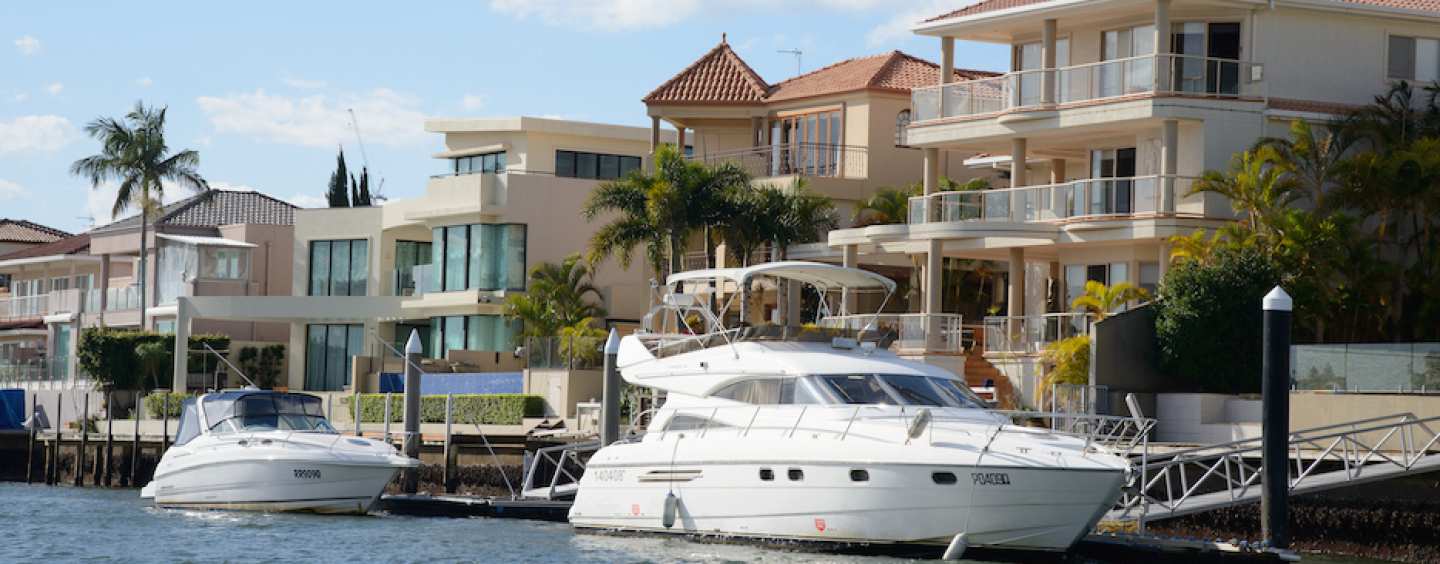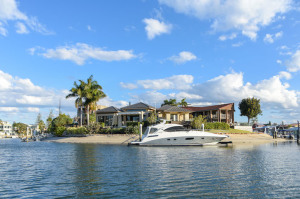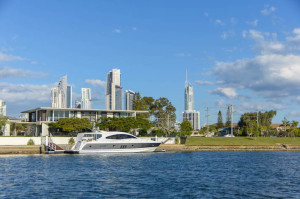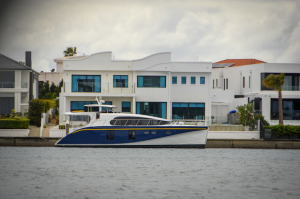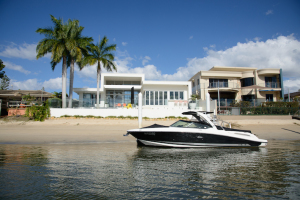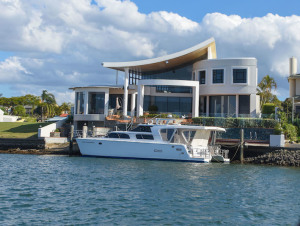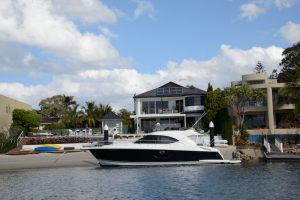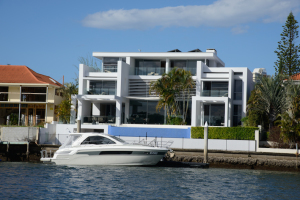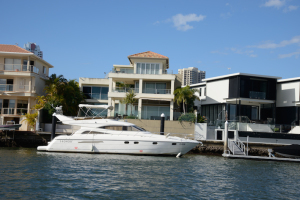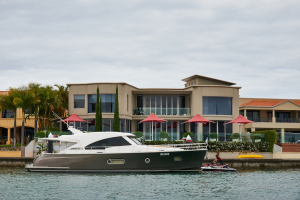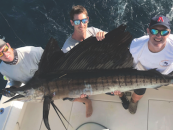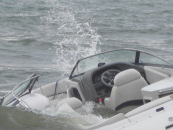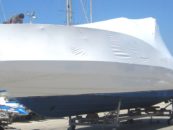The Boat Gold Coast team provide some helpful tips on choosing the waterfront home on the Gold Coast that is perfect for you. We showcase a diverse range of homes along the rivers and canals of the city through photos. The boats – big and small, power and sail, pontoon and catamaran. The decking and lawns. The boat lift and boat ramp, pontoons and jetties. With the right mindset and armed with important information, there is something to suit everyone’s needs and preferences.
Imagine this: Your backyard backyard view vividly changing with the temper of the seasons, and the ebbing and coming in of the tide provides a constant reminder of nature’s dynamics. There is no better way to combine a residential home and live the boating lifestyle than on the Gold Coast.
Living on a waterfront property on the Gold Coast with inspirational views of the waterways is a dream many boaties seek to make a reality. More than 90 percent of all residential canals in Australia are located on the Gold Coast. Although other states, such as New South Wales and Victoria, have banned the development of new canal estates, Queensland has kept its doors open for these developments, albeit with strict guidelines…So, the right Gold Coast waterfront property will be valuable in the future.
Unlike Venice canals, where there is technically no car access or road system following canals, the Gold Coast offers both land-based transport access as well as water access. When considering a waterfront home, your land-based considerations should be assessed first. Your work location, kids’ schools, proximity to shops and services, and leisure and recreational activities. Once you have defined the suburbs you want to live in, then you need to look for the right house with boating accessibility that suits you.
DIRECTION AND LAND
The direction of the property plays a vital role in your family’s comfort. For instance, a practical advice is to buy a north-to-water aspect. This will give you sun on your backyard/waterfront all day. If the house faces any other direction, you will be left with half a day in the shade, which gets very chilly during the colder months. A west-to-water aspect means you do not have sun on your backyard waterfront until the afternoon and the orange glare of the sunset fills your windows often requiring you to pull the blinds down. Aside from choosing the home with the aspect of your choice, it is also worth considering if the land fans-out towards the water or not. A block of land that fans out towards the water will allow for a larger pontoon and sufficient room to maneuver; whereas land that fans-in towards the water will have restrictive boat access and will compete for space with neighbouring jetties.
ACCESS AND WATER
There are 400 kilometres constructed canals on the Gold Coast with every navigable kilometre offering something different, often challenging, for boaties. Understanding the pros and cons of different areas is important before deciding where to buy. If you want direct and quick access to the Broadwater and Seaway, then Runaway Bay is the obvious choice. In fact, there are more registered boats in the Runaway Bay 4216 postcode area than any other postcode in Queensland, with the Runaway Bay Shopping Village having the busiest public access jetties adjacent to a shopping centre in the city. The downside is that some dead-end canals are congested with boats, and generally, the architecture of the residential houses is older than the newly established suburbs.
If you are looking into the Sanctuary Cove-Hope island-Upper Coomera areas, you have the option of choosing from many exclusive gated communities that offer a high level of security and a quieter and slower pace than the rest of the outside world. The architecture offers some of the newest on the Gold Coast. However, the Coomera River has quite a temper in the rainy summer months. Both Runaway Bay and the Coomera River areas are the choice for sailing boat owners as many sections are bridge-free and offer deep water passage. The main arm of the Coomera is a 6-knot zone for all vessels, so travelling to the Broadwater is a slow process. The northern arm of the Coomera allows vessels 8 metres or less the travel at 40 knots arriving in the Broadwater near Couran Cove, providing quick access to Tipplers, Jumpinpin, Jacobs Well and Moreton Bay.
For 8-metre or smaller vessels, the Nerang River has both 6-knot and 40-knot zones. From the Southport Broadwater, travelling by boat to locations such as Carrara will take approximately 40 minutes. Travelling by boat to Broadbeach Waters and Mermaid Waters will take considerable more time. The canals of Clear Island Waters are only accessible by Boobegan Creek lock which will add time to the journal. The benefits of living off the Nerang River is that you are never far away from the ski-access zones of the main river, the fishing is great in these waters, and you can pull up on the many beach front parklands to walk to local shopping strips. There are established public access docking at Pacific Fair and Capri on Via Roma. Like most of the canal areas of the Gold Coast, Broadbeach Waters and Nerang River areas have a well established kayaking culture with many waterfront residents using their canoes for fitness training and leisure.
While main river frontage is desirable, it carries a premium price tag. An issue for boat owners on main rivers and canals is that wake from passing vessels and wakeboard boats can be annoying and sometimes damaging to boats, pontoons and jetties. But at least you get to watch the boats pass by as entertainment. Before you buy a home, travel there by boat and see for yourself what challenges lay ahead for boat passage.
BOATS
If you buy into waterfront lifestyle but still deciding on a boat to purchase, then an entry-level investment is a tinnie or a kayak that allows you to experience the boating lifestyle and explore your local waterways without the hefty price tag. A step up the boat ownership ladder is a boat 8 metres long or less allowing you to go anywhere with ease while traveling up to 40 knots along most stretches of the main rivers. Larger boats longer than 8 metres will be restricted to 6 knots on most of the canal systems across the city. If wet berthed, these large boats can be fitted with draining skirts or boat lifts to avoid the maintenance costs associated with engines and hulls at rest in salt or brackish water for extended periods of time. While fly bridges are deemed essential further north where there are many reefs to navigate, here on the Gold Coast they reduce access to many of the canals with low bridges.
PONTOONS
If replacing an old pontoon or building a new one, there are many factors to consider before making the purchase. Piled pontoons are floating structures fixed in place with large concrete posts that are secured into the seabed. Piles are usually used in waterways that have strong tidal flow where the pontoon must be held in place firmly. In calmer waters, the pontoon can be attached to land using aluminium struts or cables. If your boat is under 6 metres long and weighs under 1,500 kilograms, you have the option to dry berth on the pontoon that incorporates a tapered end allowing for a boat or Jetski to be parked on top of the pontoon using a roller system with an electric or a manual winch. In this case, a 3.5-metre wide pontoon is recommended allowing enough space to be able to walk safely down each side of your boat. Narrow pontoons tend to be a little unstable and leave very little room for storage of kayaks, etc. If dry berthing, then extra freeboard (freeboard refers to the height the pontoon sits out of the water) is recommended so that when the boat is on the pontoon the aluminium frame work will also be out of the water. The extra free board height is very important if you are positioned on a main river with ski zones (like the Nerang and Coomera rivers). A pontoon that has a high freeboard will be more durable and can handle crashing waves from power boats and will stay drier, as passing power boats, especially wakeboarding boats, make large waves.
It is worth noting that council regulations allow your pontoon length to be up to 70 percent of your total waterfront property length.
Editorial by Andy Kancachian






















